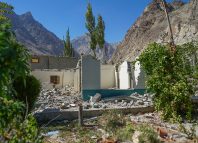Another one strikes: Multiple earthquakes leave vulnerable communities in Afghanistan without shelter and basic amenities
Photo credit: CWSA staff on the ground
Afghanistan’s western region, particularly Herat province, experienced a wave of earthquakes in just a span of a week, with the third and latest one hitting the province on October 15th (Sunday) at a 6.3 magnitude and claiming two more lives and leaving 170 people injured1. An estimated thirty new villages across two districts were affected by the earthquake on Sunday, with assessments ongoing2.
According to latest reports, a total of 43,395 individuals (comprising 7,165 families) have been directly affected by the earthquakes in Injil (23,053 people), Kushk/Rabat-e-Sangai (8,541 people), Zindajan (7,523 people), Gulran (3,428 people), Herat (717 people), and Kohsan (133 people) districts. The district most severely impacted is Injil, with 53 percent of its total population left severely affected by the earthquakes. Over 3,330 houses have been left completely destroyed and 2,137 houses severely damaged, with the majority of these losses occurring in the Zindajan district.
Casualty figures of the third earthquake are expected not to rise significantly as a majority of the affected communities had already evacuated their houses, taking refuge in open spaces due to a high probability of their houses collapsing due to aftershocks. The earthquakes have also caused substantial harm to critical community infrastructure in affected villages, such as schools, health clinics, and other essential facilities. To add to the crisis, a severe storm hit the ZindaJan district on the evening of October 12th, resulting in an additional displacement of three hundred households from multiple villages to Herat City3.
Following the earthquakes, families are living out in the open, in makeshift shelters, or in informal settlement sites, leaving them vulnerable to weather, health and other protection hazards. The earthquakes have struck vulnerable communities, already living in poverty who had little or no means of income. With the harsh winter approaching, affected communities need temporary and transitional shelters, access to safe drinking water and other WASH supplies, food, warm clothes and heating essentials to help them survive. With damage to schools and community-based education facilities, children need to safely resume education. Protection support is also needed, particularly for vulnerable groups such as women and children, the elderly, and people with disabilities.
Community World Service Asia’s Response
To meet the immediate needs of the most vulnerable earthquake affected families, Community World Service Asia (CWSA) has started assisting 100 families with winterised tents in Zindajan district. Of these thirty are women-headed households and three of those supported are led by children, left orphaned after the earthquakes. Our team is on the ground and is in the process of verifying project participants and so far, five hundred families have been verified as per the criteria set:
Households with deceased members
Households with injured members
Households headed by women or left as widows
Households headed by children or left as orphans
Households with fully damaged houses
Households with partially damaged houses
Community World Service Asia is in close coordination and continuous communication with relevant stakeholders, including UN-agencies, local authorities, and community members to ensure consistent coordination and an effective response.
“I was outside the house when the earthquake struck. I lost nine family members, including my husband, two sons, four daughters and my daughter-in-law with her son. They were all trapped inside the house at the time of the earthquake, with the house collapsing on them. Now, I am left with ten other family members, including my six remaining children, three daughters-in-law, two and a granddaughter. We are left without a house and no belongings. While we have received a tent, with winter approaching, we are in need of warm clothing, blankets, and food. It was a devastating experience, as my surviving sons were unable to reach the members trapped under the rubble in time,” shared a grieving 58-year-old mother named Badroo, from Sarbland Village in the ZindaJan district.
CWSA’s key areas for immediate emergency response are:
» Emergency shelter: 1000 winterised tents → Budget: US $ 420,000
» Multi-Purpose Cash Assistance (MPCA) for 3 months for 1000 affected households → Budget: US $ 1,590,000
» Winterisation Kits: 1000 kits for a thousand affected families → Budget: US $ 420,000
» Quality & Accountability Resources & Training → US $ 35,000





















